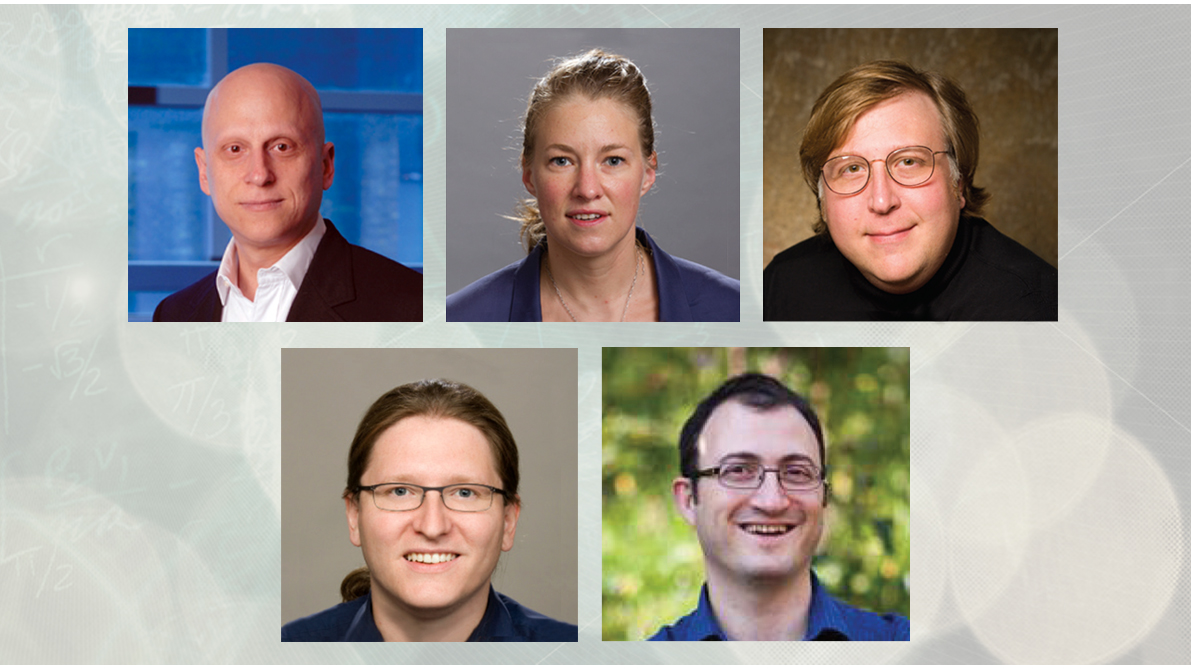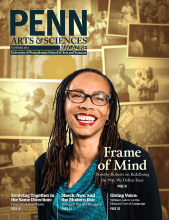In 1998, the eminent American biologist Edward O. Wilson published a book called Consilience: The Unity of Knowledge. It was a passionate yet scrupulously reasoned argument in favor of bringing together all fields of knowledge, using the fundamental natural laws and concepts that underlie everything.
While such unity may be elusive, the old-fashioned divisions among the natural sciences have been eroding. The tools of science have become ever more sophisticated and versatile, revealing a common ground that scientific disciplines share—and encouraging scientists in one field to look through the conceptual lens of another.
At Penn Arts and Sciences, boundary-crossing in the sciences is receiving an extra push through an innovative initiative with a daunting name: the Evolution of Dynamical Processes Far From Equilibrium Cluster. Also known as the Evo Cluster, the initiative is shaping faculty recruitment efforts across the School’s natural science departments, with the goal of strengthening resources and sharpening the focus on some of the biggest questions in science today.
The Evo Cluster initiative builds on the kind of interdisciplinary work that was already taking place at Penn Arts and Sciences. In July of 2012, as Edmund J. and Louise W. Kahn Professor of Biology Mark Goulian half-jokingly claims, the School’s Department of Physics and Astronomy did something that no physics department has ever done before in the history of the world: It hired a biologist. “A real biologist, not a biophysicist, but someone who’s a card-carrying biologist,” Goulian emphasizes. That biologist was Alison Sweeney, now an assistant professor of physics.
Sweeney’s research focuses on the novel and counterintuitive ways in which animals interact with light. “Vision is clearly the primary example you think of, but it turns out that animals do all sorts of other pretty sophisticated and nuanced things with regard to light,” she explains. Studying how squids, for example, change their camouflage in differing light conditions, or how giant clams are able to harvest every last photon that strikes their tissues, ranges far beyond biology into questions of physics, materials science, evolution, and behavior.
"My work is not an easy fit for a very traditional department." – Allison Sweeney
“By the time I got to the end of my postdoc … I was doing this work that was really fascinating to me and I had suddenly become arguably too ‘physics-y’ for a traditional biology department,” Sweeney recalls. Penn Arts and Sciences was different. “Penn physics was hiring someone in biophysics and the job description sure looked a lot like the work I was already doing, so I went ahead and threw my CV in the ring, and lo and behold, they interviewed me and offered me the job,” Sweeney says. “So now I’m doing the work I’ve always wanted to do and found most interesting, and it turned out that I needed to get myself into a really great soft matter physics department in order to make that happen most effectively. I think my work is taking on a new level of sophistication and physical nuance that would be much harder to come by if I were housed in a biology department.”
Years before Sweeney came to Penn, Goulian himself walked a similar path between two disciplines. He is a physicist by training and was originally hired by the Department of Physics and Astronomy in 2000. But as his research emphasis shifted away from soft matter physics toward the regulatory signaling circuits by which bacteria interact with their environment, he found himself becoming more of a microbiologist in practice. “It was really just a question of where was I going to end up putting my efforts,” he remembers. “In the end, I think where I ended up really having the most traction and where my research really took me was further and further in the biology direction.” He finally changed departments to biology.
These migrations across disciplinary territory did not go unnoticed by Richard Schultz, Charles and William L. Day Distinguished Professor of Biology and the School’s Associate Dean for the Natural Sciences from 2008-2014. Noting the “growing movement towards collaboration” across the sciences, Schultz played a key role in leading faculty in a process of identifying big issues that might inspire and benefit from even closer collaboration, asking them to consider “What are the big ideas? What are overarching questions within the natural sciences that people see as opportunities where we have an existing strength that we could build on?”
In the course of these discussions, evolution emerged as an obvious theme. As Schultz points out, “You can see evolution from the evolution of molecules to the evolution of the universe. It scales tremendously, the evolution of the biological world, the physical world. All the departments can hang their hat on that, they all have it.”
Professor of Linguistics Robin Clark would agree. Clark uses game theory approaches to study the ways in which languages evolve and change over time. “If you look simply at language as a kind of object and you just take a snapshot of it, then a lot of the stuff going on is probably not going to make a lot of sense, it’s just going to look arbitrary,” he observes. “But if you think of it in terms of an evolutionary process, it may well make a lot of sense. Some of the ideas coming up are whether the sort of processes that affect language can be accounted for in a way that’s very similar to biological evolution.”
Languages and the words that comprise them are not living organisms, and the forces that affect their evolution are not those that work on living creatures. Yet many, if not most, of the same basic evolutionary pressures and processes remain. It’s that sort of synergy upon which the Evolution Cluster operates. “There are many areas which at first might seem disparate.” Clark says. “It’s easy to think of biological processes as evolutionary, but what about a chemical process, or a physical process that does not involve some sort of selection? Well, these involve dynamics and are evolutionary to one degree or another. To the degree to which we can characterize them, we can start to build a real theory of evolutionary dynamics as an independent field, and understand things like how evolution could affect information, or a physical or chemical process, or the process of soil formation. If you find out what the common properties are, that’s pretty exciting, I think.”
Says Randall Kamien, Vicki and William Abrams Professor in the Natural Sciences in the physics department, “We realized that evolution could be so broadly construed—it could be evolution of language, of cultures, of social networks, riverbeds, veins of leaves. We realized that this was a huge leitmotif that recurs over and over again in different fields.” Fresh from chairing the search committee that brought Alison Sweeney to the physics department, Kamien was chosen to head the committee for the first faculty search under the new Evolution initiative.
That first recruit was soft-matter physicist Eleni Katifori. Currently a group leader at the Max-Planck Institute, Katifori will be joining Penn’s Physics and Astronomy Department in 2015—but she is already working closely with Alison Sweeney and reaching out to other Penn faculty with an eye toward collaboration. Her research centers on the physics of living organisms, specifically the vasculature inside leaves that transports vital nutrients and energy throughout the plant. That involves not only how such systems work, but how and why they’ve evolved and their commonalities with other biological systems—not the sort of issues a physicist would usually consider. “My work is not an easy fit for a very traditional department,” she admits. “They’re not going to allow people to do the type of things that I do. But Penn is an optimal environment for me.”
Mark Goulian notes that “sometimes it’s in breaking away from the literal applications to your own research that you get some of your more creative ideas.” Increasing the opportunity for faculty to think about their research questions from a different perspective is a benefit that is already being realized through the Evo Cluster. Theoretical biologist Erol Akçay, who joined the biology department in January 2014, specializes in the evolutionary and ecological dynamics of social behavior. The assistant professor has already has struck up fertile working relationships with Professor Joshua Plotkin, a mathematical biologist; linguist Clark; and animal behaviorists in the psychology department. Even before he arrived officially, Akçay says, “It was obvious that there were going to be a lot of opportunities for interaction. When I arrived on campus a lot of people I wanted to interact with already knew who I was and were looking forward to talking to me.”
One of Akçay’s collaborators is Baird Assistant Professor of Psychology Joe Kable, who studies the mechanisms of decision-making, both from a neuroscientific and theoretical perspective. “One of the things I’m interested in with decision-making is understanding why there would be individual differences in our preferences. Why would some of us be very impatient and want everything now, while others are willing to be more patient and willing to wait for delayed outcomes and rewards? Usually if a behavior is beneficial, evolution should be pushing everyone towards that. So I think there are interesting questions about how you explain individual differences and personality from an evolutionary viewpoint.”
Akçay’s collaboration is providing Kable with a new perspective on these questions. Kable notes, “As an evolutionary theorist, he has the analytic and mathematical tools to ask those kinds of questions, and I have the data that plainly shows that people are quite variable in levels of impulsivity and risk taking. A big unanswered question is explaining that diversity, so we’ve been working together on that.”

THE PENN EVOLUTION CLUSTER
The following statement was developed by Penn Arts and Sciences faculty describing the basis for the Evolution Cluster initiative.
We live in a world of evolving structures and patterns. From the emergence and proliferation of life, to the development of society and language, to the dynamically changing climate and contours of the planet, natural scientists are confronted with understanding systems that are ceaselessly evolving – often into ever more complex forms. Scientists have been tremendously successful in understanding patterns for systems that have stabilized into an unchanging state of equilibrium, but the dynamical patterns of evolution owe their existence to being out of equilibrium. Equilibrium techniques developed serially in the physical, life, and social sciences over the past two centuries do not suffice to describe dynamics far from equilibrium. And so these fields all face this new frontier in parallel, raising the opportunity for a synergistic approach.

HOW TO HERD CATS
From the start, the Evolution Cluster idea was an almost radical notion. “Usually when there’s a search in a school, it’s predetermined as to which department will get the new hire,” Randall Kamien explains. “So even if the search committee is composed of people from other departments, you already know it’s going to be somebody in math or in chemistry, for example.”
But with the Evolution Cluster hires, all of the School’s seven natural science departments were involved. That sort of collegiality is almost unheard of in academia. Kamien notes, “Everybody I’ve talked to outside about this just wonders, how could you possibly get seven departments to cooperate? It might be something other universities want to do but I don’t think it’s something that they can constitutionally do. Penn’s really in a special position to be able to do this.”
Other faculty members agree. Mark Goulian says, “I think one of the most interesting things about it is that it was an experiment. It wasn’t clear whether it could work, that you could bring all these departments together, and so far it’s been remarkably successful, if you look at the number of hires that have come out of it.”





